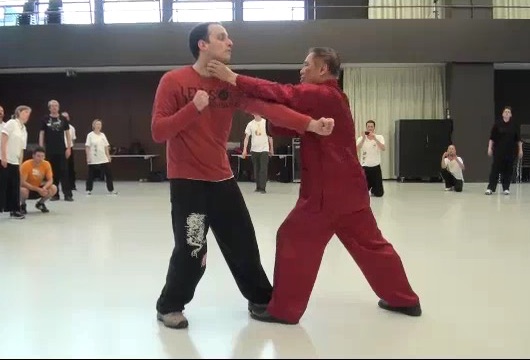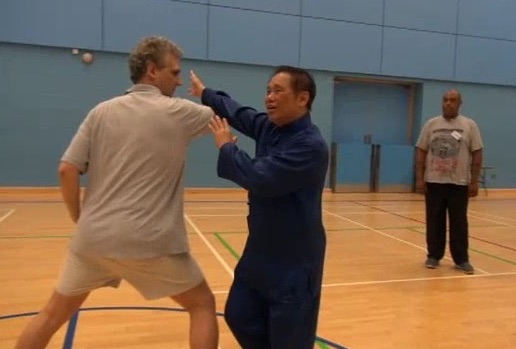DIFFERENT STRATEGIES IN SEVEN-STAR AND TAIJIQUAN IN OVERCOMING BIGGER, STRONGER OPPONENTS

Combat application of Seven-Star Set
Question
Both Tai Chi Chuan as well as the Seven Star Set are said to be excellent choices if a physically weaker or smaller person wants to overcome a stronger opponent.
Looking at the Seven Star Set video I get the impression that they both use different strategies to achieve this.
What are their differences and/or similarities in terms of strategy to overcome a stronger opponent?
And related to this: What benefits will our Tai Chi Chuan practitioners get from learning and practicing the Seven Star Set?
Sifu Andrea Zilio
Answer
Yes, both Taijiquan and the Seven-Star Set are excellent for small-sized exponents against bigger-sixes opponents. But they use different strategies to achieve this purpose.
Before explaining the different strategies, it may be worthwhile to point out that Taijiquan is a kungfu style whereas the Seven-Star Set is a kungfu set. There can be many kungfu sets in a kungfu style, and different styles may have a set with the same name, though the sets may actually be different in other aspects.
In our school, for example, Taijiquan has many sets like Cloud Hands Grasp Sparrow, Old Eagle Catches Snake and Flowing Water Floating Clouds. The set called Taming the Tiger is found in styles like Hoong Ka, Choy-Li-Fatt and Northern Shaolin, and they are all different though they have the same name.
As far as I know the Seven-Star Set is found only in Northern Shaolin. It is a very old set, extending back to the Song Dynasty which was about 1000 years ago. Because of its long history, there are different versions of the set, or they could be different sets.
The Seven-Star Set in our school was from my sifu, Sifu Ho Fatt Nam. He learned it from his simu, who was tiny but very combat efficient.
It is interesting to compare the different strategies used in Taijiquan and the Seven-Star Set to combat bigger sized opponents.
Taijiquan makes use of two important principles to minimise an opponent’s force. namely waist rotation and body movement.
Instead of meeting a powerful force head-on, a Taijiquan exponent deflects it away in a circular motion. Suppose a punch with 100 units of force is coming at you. To stop it head-on, you need at least 100 units of force. If you block it away diagonally, by moving your arm you may need 50 units of force.
But as soon as the punch comes in contact with your arm, without moving your arm but rotating your body, you can deflect the punch with only 10 units of force. Not only your waist rotation deflects the punch, you also bring your opponent forward near to you for your counter-attack. This is the principle of waist rotation.
The other important principle is body-movement — without moving your feet. As the punch with 100 units of force is coming, you move your body backward, without moving your feet, by shifting your stance back. You need zero units of force to avoid this powerful punch. You did not block it; you avoid it my moving the target away.
However, the punch is still pointing at you, which may not be favourable. So you also deflect it away as you move backward, in which case you need only 5 units of force, not 10, to do so. This movement of using minimum force against maximum strength is well illustrated in our Pushing Hands.
There are a few interesting points worth mentioning regarding this strategy of waist rotation and body movement.
Taijiquan is said to derive from 13 techniques, which are warding off, rolling back, pressing forward, in contact, taking, diagonally flying, elbowing, anchoring, moving forward, moving back, moving to right, moving to left, remaining at centre. I knew the first twelve, but was puzzled at remaining at centre. Then, in a flash of inspiration, I realised it meant body movement.
“Using minimum force against maximum strength” is best expressed in Chinese as “si liang po jian jin” which means “4 taels against 1000 catties” or “4 ounces against 1000 tons”. One should note that at least 4 ounces are needed; it is not totally without force.
When you use 4 ounces of force against an opponent’s 1000 catties, it does not necessarily mean that you don’t have much force. You may have more than 1000 catties of force, but you choose to use only 4 ounces to defeat him.
The strategy of the Seven-Star Set is different. While Taijiquan strategy may be represented as circular, that of the Seven-Star Set is straight. Straight here does not mean head-on. The movement taken by a Seven-Star exponent may be slightly curve, but its curvature is so slight that it appears like straight.
Suppose a punch with 100 units of force is coming at you from north to south, or from 0 degree to 180 degrees. If you move your defence from 180 degrees to 0 degree, you will meet his attack head-on, and you will need more than 100 units of force to stop it. If you move your defence from west to east, or from 270 degrees to 90 degrees, you will need about 50 units of force to block his attack.
Now you move from 190 degrees to 0 degree. Your movement is not a defence, it is an attack, using the tactic of “no-defence-direct-counter”. No-defence is a misnomer. the defence is incorporated in the counter-attack. Somewhere about half-way your counter-attack will brush off and deflect his attack. You do not block his attack; you brush it off with little effort. You need only about 5 units of force to brush off his 100 units of force, and you hit him at about the time he has completed his attacking movement.
Another strategy used by a Seven-Star exponent is to hit an opponent from a side as he attacks from the front. As his punch of 100 units of force is coming at your from north to south, you move from south to east or west and strike him at the same time. Here you don’t even need 5 units of force for defence; you move the target away from his attack, and simultaneously counter-attack him.
If you look at the Seven-Star Set, the techniques appear linear. This is deceptive. Kungfu is alive — a fact I learned from my sifu in my student’s days. The apparently linear techniques in the set can be used in any direction. It was not without good reasons that my sifu asked me to practice just the seven-star jump every night for many months.
If all other things were equal, I would consider the strategies in the Seven-Star Set even more effective than those in Taijiquan. An obvious advantage is speed. Seven-Star responses are faster than those in Taijiquan. Another element is surprise. A Seven-Star exponent often surprises his opponents, striking them sometimes before they have completed their attack!
Taijiquan practitioners, in fact practitioners of all other styles, can benefit a lot from the Seven-Star course. The mere fact of learning strategies that are different from those prominent in ones style is a great benefit by itself.
The benefit is two-fold. Not only you can apply the different strategies on your opponents, you can handle then well if your opponents use those strategies on you.
A third benefit is that the different strategies enable you to see things from new perspectives. You are not limited to what you have been familiar with. And the new perspective can extend beyond the two different ways for smaller exponents to overcome bigger opponents.
Just as you may have more than 100 units of force but use only 5 units to defeat your opponent, you may have many strategies and perspectives but use only one appropriate strategy or perspective in combat or daily life. This makes you unfathomable — a sure sign of a high-level master. Opportunities for breadth and depth in our school enable us to accomplish this ideal.
More importantly, the Seven-Star course gives us more philosophy, techniques and skills to enrich our daily life.
If someone asks you a question which you may not want to give a direct answer, for example, like asking, “How old are you?”, you may answer it in the Taijiquan way. You can use the strategies of body movement and waist rotation, and then counter attack him, by saying, “Ah! that’s an interesting question. It is not so important how many years you have lived, but how well you have lived those years. I have lived my years very well. Have you?”
Or you can use the Seven-Star way, saying, “I look more youthful than you. Do you practice the Sven-Star Set?”

Combat application of Taijiquan
The above discussion is reproduced from the thread 10 Questions on the famous and legendary Seven-Star Set (七星拳)
LINKS
